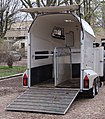Trailer (vehicle)
![]()
This article is about the vehicle trailer. For further information see: Trailer (disambiguation).
![]()
This article or paragraph presents the situation in Germany. Help describe the situation in other countries.
Trailers are vehicles that usually have a loading area for transporting goods, but do not have their own drive. They are towed behind towing vehicles such as cars, trucks, buses, tractors, motorcycles (see motorcycle trailer) or bicycles (see bicycle trailer). Rail-mounted trailers are called freight cars, wagons, or lorries. As a rule, trailers are towed; in rail transport, trailers are also pushed.
Trailers are named and defined according to DIN 70010 (systematics of road vehicles). This is done in accordance with ISO standard 3833, which includes trailers and their technical characteristics. Trailers transfer the load to the road mainly via the wheels, except for the drawbar load - in the case of single-axle trailers - which is borne by the towing vehicle. The towing forces are transferred from the towing vehicle to the trailer via the so-called drawbar. A trailer coupling is used to connect the towing vehicle and a trailer or to connect trailers if several trailers are coupled to the towing vehicle.
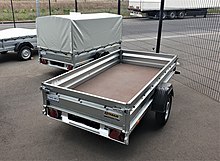
Trailer for use on the car
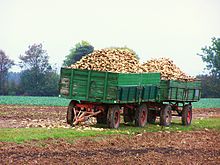
Trailer in agriculture
Types of construction
The following basic types of trailers are mentioned:
- Rigid drawbar trailer
- Articulated drawbar trailer
- Semi-trailer
- Special designs
Rigid drawbar trailer
In rigid drawbar trailers (SDAH), the drawbar is rigidly connected to the trailer frame. It has one or two axles (rarely three), which are also rigidly connected to the frame. Almost all car trailers are built as rigid drawbar trailers. In Germany, according to the StVZO (German Road Traffic Licensing Regulations), which have been harmonised in the EU, as in Austria, a trailer with a gross vehicle weight (GVW) of up to 750 kg is considered a light trailer and does not need its own brake. From this total weight, a brake is mandatory. In Europe this is usually an overrun brake. Overrun brakes are permitted up to 3500 kg gross vehicle weight. Heavier trailers require a continuous brake system, this is almost always an air brake.
Most caravan trailers, boat trailers and motorcycle transport trailers are rigid drawbar trailers with one axle or a tandem axle. Special trailers are, for example, horse trailers, which are predominantly designed as tandem trailers. Various suspension systems are offered here depending on the intended use, such as rubber spring axles, torsion bar spring axles, torsion spring axles and coil springs.
When two axles are built close together on a trailer, the driving behaviour is similar to that of a single-axle trailer. Such trailers do not need a turntable - the drawbar is firmly connected to the trailer chassis and both axles cannot be steered. This comes at the price of higher tire wear on tight radius turns. If the axles are spaced less than 1 m apart, they are considered single-axle by law in Germany; the term tandem trailer has become established for this. This has no influence on the toll, because here every visible axle counts. However, the tandem axle must be taken into account in the driving licence regulations, where, for example, a truck with an axle load of up to 7.5 t and a single-axle trailer with an axle load of up to 11 t may be driven with the old German class 3 car driving licence.
· 
Light unbraked car trailer
·
Boat trailer with overrun braked slip trolley (Varianta 65)
· 
Caravan with tandem axle (overrun brakes)
·
Horse trailer with double axle (overrun brakes)
· 
Motorcycle transport trailer (overrun braked)
· 
Tandem trailer with air brake system (truck)
Articulated drawbar trailer
These trailers have two or more axles, of which the front axle is steered via a turntable (hence also called a turntable trailer) or, less commonly, via individually steered steering knuckles. These trailers are typical of trucks and tractors. Recently, car trailers of this design have been offered for light long or volume transports. The permissible total weight is up to 20 tonnes with two axles and 24 tonnes with three axles - with special approval (low loader for heavy transport) above this.
With turntable steering, the front axle is mounted on a turntable and firmly connected to the drawbar. The drawbar is mounted so that it can move in a vertical direction and is held in place by strong springs as a safety precaution. It must not touch the ground after uncoupling. Multi-axle trailers over 3500 kg GVW must be equipped with an air brake.
The body types are, similar to the truck, very versatile. Typical body types are the open box (platform), the open box with tarpaulin and frame and the closed box (box body). In addition, there are many special body types that are adapted to the respective application.
·
Two-axle articulated drawbar trailer (overrun braked on one axle/truck)
· 
Three-axle articulated drawbar trailer (overrun braked/car)
·
Three-axle articulated drawbar trailer (truck/tractor)
· 
Four-axle articulated drawbar trailer (truck)
·
Bus trailer with stub axle steering
Semi-trailer
The semitrailer, usually called a semi-trailer, does not have a front axle, but rests with its front part on the tractor unit. Together with the tractor unit, it forms the articulated vehicle. For some years now, semi-trailers have increasingly been fitted (with special approval) with a dolly front axle so that they can be attached to the EuroCombi in the EEA states.
· 
Semi-trailer (bulk goods)
·
Semi-trailer (general cargo)
· 
Container chassis
· _container_on_a_skeleton_trailer,_25_January_2010.jpg)
Semi-trailer with 20-foot container
· _container_on_a_skeleton_trailer,_24_January_2009.jpg)
Semi-trailer with 40-foot container
·
Semi-trailer with lift axles
· 
Semi-trailer with loading crane
Special forms
- The road scooter (colloquially Culemeyer) is a vehicle trailer developed in 1931 by Johann Culemeyer for transporting railway wagons and heavy loads on the road. This multi-axle trailer was available in various designs with different payloads.
- A trailer that is used for particularly long goods, such as logs or prefabricated parts, is referred to as a trailing trailer. When loaded, the trailer is usually connected to the towing vehicle by a central tube, a wire rope or only by the load for towing.
- A tow axle is used to tow light motor vehicles with a jacked-up axle. Unloaded, it is to be driven like a single-axle trailer, loaded like a multi-axle trailer.
- Push trailers have their own engine, mostly for vehicles with weak own drive, for example bicycles and mopeds. They are not eligible for registration in Germany.

Road roller with tank wagon
Legal regulations in Germany
Load types, dimensions and weights
Total mass
This is the mass calculated from the sum of all axle loads of the individual vehicles (unhitched). The permissible total mass is relevant, among other things, for the question of the correct driving licence and the type of brake system. The maximum total mass of a tandem trailer (axle distance less than 1 m) may be 11 t, a two-axle trailer may have 20 t and a three-axle trailer 24 t zGG.
Support load
The drawbar load is the load that rests vertically on the trailer coupling when it is coupled. The higher the drawbar load, the better the handling in general. However, the maximum permissible drawbar load of the coupling must not be exceeded. With a permissible total weight of no more than 3.5 t, the minimum drawbar load must not be less than 4 percent of the actual total weight of the trailer, but it need not be more than 25 kg.
Towing capacity
The trailer load is the actual load regardless of the maximum permissible total mass. For single-axle trailers without a bogie, the drawbar load counts as part of the vehicle load. The trailer load is therefore the actual total mass of the trailer minus the drawbar load. For example, if the towing vehicle has a permissible towable mass of 1200 kg, a trailer of mass 1250 kg may be towed if the drawbar load is 50 kg and this is within the permissible drawbar load range for the trailer coupling.
Length, width and height
The total length of a trailer must not exceed 12 m, the width 2.55 m and the height 4 m.
Chassis and suspension
In the case of trailers, the oldest and most widespread type of chassis is the ladder frame to which rigid axles were attached. The undamped rigid axle design can still be found on older trailers in agriculture and forestry and on light transport trailers. The most common type of suspended axle is the leaf suspension, which is designed as a parabolic or trapezoidal suspension. In more recent times, this has increasingly been replaced by independent wheel suspension and air suspension (rolling lobe). The first vibration dampers were scissor-type dampers; more recently, hydraulic shock absorbers in conjunction with rolling lobe bellows have become state of the art.
Brakes
History
First trailers were equipped without their own brakes. In 1908, with the regulations of the subsidy trucks and the emergence of road trains, brakemen were mandatory, who sat on the trailer and operated the trailer's block brake. In 1913, the brakeman on the trailer was eliminated and by 1915, regulation 3-ton trucks became the predominant type of truck in Germany. Until after World War I, trailers did not normally have their own service brake. There was also no limit on the number of trailers, so by 1925 trucks with up to four trailers were in service. The maximum speed for heavy trucks (over 5.5 t) with trailers was limited to 16 km/h in towns and 25 km/h outside towns.
On 1 January 1926, with the introduction of the new ordinance on motor vehicle traffic, the permissible weight was limited to 7.5 t and the number of trailers to one. The trailer - if it had more than one axle - had to have its own service brake from 1926; technically this was not a problem, as the Knorr compressed air brake had already been introduced in 1923. The overrun brake, on the other hand, was not introduced until 1936 for light trailers, and in the first StVZO of 1937, approval was required for trailers with a gross vehicle weight of over 5.5 t or a maximum speed of over 20 km/h. Two trailers with overrun brakes were not permitted. As a result of a circular issued during the Second World War on 15 June 1940 (RGBl. p. 220), two trailers with overrun brakes were permitted behind motor vehicles (trucks) with immediate effect.
It was not until 25 November 1951 that the StVZO was reset to its pre-war status. In the same year, the introduction of the return lock valve on the air brake system prevented the total failure of the brake of the towing vehicle if the trailer was lost. In the 1960s, ATE offered the "Hydrakup", a hydraulic brake system for car trailers. The car's hydraulic brake system was connected to the trailer via two coupling parts (motor vehicle and trailer coupling head); the braking effect of the trailer's drum brakes started with the towing vehicle. In 1967, Daimler-Benz introduced the spring-loaded brake for the parking brake on the air-braked trailer.
For trailers over 25 km/h bbH, the dual line brake was prescribed by Directive 71/320/EEC of 30 July 1971, which had to be implemented by 30 January 1973. In the single-line system, which operated with a maximum system pressure of 5.3 bar, the trailer is connected via a control line which simultaneously fills the trailer's air reservoir. When braking, the trailer's air supply is not replenished as a result. In the case of long downhill stretches or leaks, the braking force is considerably reduced. In 1981, Daimler-Benz introduced a WABCO anti-lock braking system on truck trailers. On 1 January 1991, an EC brake system was made compulsory in accordance with Directive 71/320/EEC, which had to have two brake circuits and a load-dependent brake force regulator. Since 1 January 2001, an automatic anti-lock braking system has been mandatory for newly registered trailers over 3.5 t.
· 
Block brake
·
Single-line air brake (in agriculture)
· 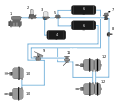
Dual-circuit air brake (body)
· 
Overrun brake (ball head coupling)
·
Cable-operated overrun brake on tandem axle
Current regulations
up to 750 kg
No separate brake required.
up to 3500 kg
Overrun brake permissible. Permitted at a maximum speed of 25 km/h up to 8000 kg GVW; up to 40 km/h with an overrun brake on each wheel. Overrun brakes are not permitted on semi-trailers. Two trailers with a maximum weight of 8000 kg each are permitted behind tractors with overrun brakes if the maximum speed is 25 km/h.
over 3500 kg
Two-circuit compressed air braking system prescribed. These trailers must also - if the maximum speed is above 60 km/h - be equipped with an anti-lock braking system.
over 9000 kg
Trailers must be equipped with a continuous brake (service brake) whose braking power is equivalent to the fully loaded vehicle travelling down a gradient of 7 per cent and 6 km at a speed of 30 km/h.
Wheel chocks
Trailers must be equipped with wheel chocks. Two-axle trailers (except semi-trailers and rigid drawbar trailers) over 750 kg GVW require one wheel chock. Two wheel chocks are required for three-axle and multi-axle vehicles, semi-trailers, rigid drawbar trailers over 750 kg GVW.
Clutches
Pin coupling
The first detachable trailer couplings are known from 1904, but a "trailer industry" did not emerge until 1912. In the 1920s, different coupling systems were used; in 1925 alone, 17 different pin couplings were counted. Simple pin couplings are still used today for unbraked trailers in agriculture and forestry as well as in construction site operations.
Mouth coupling
The manufacturer Rockinger developed an automatic jaw coupling in 1927, for which he received a US patent in 1932. The manufacturer Ringfeder from Uerdingen produced a similar product for the railway sector as early as 1923. These systems of automatic locking, in which no person has to be between the towing vehicle and the trailer during the coupling process - according to today's accident prevention regulations, this is strictly forbidden - became established worldwide in the commercial vehicle sector. Maul couplings in the truck sector with an eye diameter of 50 mm achieve D values of 200 kN and Dc values of 135 kN. In agriculture and forestry with an eye diameter of 40 mm, the D value is 120 kN.
Fifth wheel
A fifth wheel coupling with king pin is required for the semi-trailer. The first patents of a detachable semi-trailer were granted in 1932, but the first semi-trailer was already presented in the 1920s with the "Oekonom-Großflächenwagen".
Ball head coupling
Detachable quick-release ball couplings were already offered on motorcycle hitching in the early 1930s. Franz Knöbel was granted a patent for the ball-head coupling on 14 March 1934. The manufacturer Westfalia achieved worldwide fame with this invention. The ball diameter of 50 mm at that time is still the standard for passenger cars today. For trailers (without/with overrun brake), the ball head coupling is today's coupling standard. The non-automatic ball head coupling is permissible for trailers in agriculture and forestry - a ball with a diameter of 80 mm and a D-value of 90 kN is common there - as well as for a trailer weight of less than 3500 kg.
· 
Pin coupling (tractor)
· 
jaw coupling (tractor)
·
Fifth wheel (tractor)
·
Ball head coupling (tractor)
· 
Towing eye (trailer)
· 
Towing eye of a dolly (trailer)
·
King pin (semi-trailer)
·
Ball head coupling of the trailer (no overrun brake)
Electrical and mechanical connections
Lighting
The same regulations regarding lighting apply to trailers as to all motor vehicles. The trailer must have tail lights, brake lights, indicator lights and one or two rear fog lights. One or two reversing lights may be fitted. The power supply for the lighting is provided by the towing vehicle. The plug connection is either 7-pin or 13-pin and standardised. For details, see the article Trailer socket.
Mechanics
Detachable trailer couplings are found in the ball head coupling range. If the drawbar load is over 50 kg, a height-adjustable support device is prescribed for rigid drawbar trailers, which must be accommodated in a "captive" manner.
With the jaw and fifth wheel coupling, the braking force is transmitted by compressed air. The supply line (red) and the brake line (yellow) must be connected to the towing vehicle in the same way as the electrical connections. If the supply line is not connected, the trailer control valve will not open. If the supply line is disconnected while driving, the trailer brake valve triggers emergency braking of the trailer.
Breakaway cable
For trailers with overrun brakes, the use of a breakaway cable is mandatory. This is connected to the trailer brake mechanism and is attached to the ball head hitch of the towing vehicle by means of a loop and snap hook. As soon as the trailer unexpectedly detaches from the towing vehicle while driving, the trailer's brake is applied so that the trailer comes to a standstill independently.
·
Ball head on the car and electrical connection (below)
·
Breakaway cable (red) of the overrun brake
·
Support wheel
·
Connections on the articulated vehicle (2 × compressed air, 3 × electrics)
Reflectors and reflectors
On all trailers, two red reflective triangles (reflex reflectors) are prescribed at the rear, which must be mounted with one tip pointing upwards. The equilateral triangles must have an edge length of at least 15 cm. Yellow, non-triangular reflectors are required on the side, and yellow side marker lights are required from a trailer length of 6 metres. Trailers with a width of more than 2.1 m must have outline marker lights that appear white to the front and red to the rear.
Tail marker boards
For trailers in EU vehicle classes O3 and O4 (with a maximum permissible mass of more than 3.5 tonnes), rear marking plates, which are contour markings in accordance with ECE No. 70, are mandatory from first registration 10 July 2011. The purpose of the requirement is to draw the attention of the following vehicle to the train, as a longer overtaking distance must be expected when overtaking. One, two or four panels may be used and must be rectangular, have a yellow reflective background and a red reflective border. The length of the rear marking panel must be between 113 and 230 cm, the width 20 cm.
Trailer triangle
The trailer triangle was mandatory in Germany (German Reich and thereafter in the FRG as well as the GDR) from April 1, 1938 to 1956 according to § 44 of the StVZO. It was foldable and the yellow surface was internally illuminated. A corresponding regulation also existed in Austria.
In Denmark, since around 1990, there have been warning cones on cars at the level of the front wheel to indicate to cyclists that a trailer is following.

Old trailer triangle
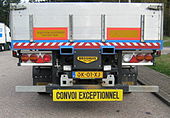
Two rear marker boards
Search within the encyclopedia

